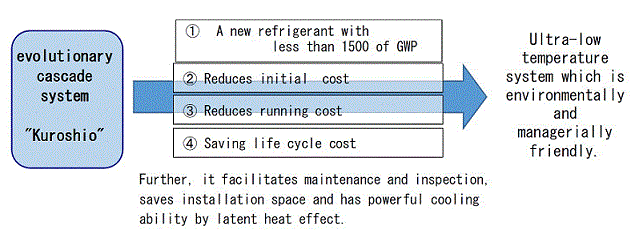Refrigeration | Freezing technology reaches cells! Advancing low-temperature world
Nissin Refrigeration & Engineering Ltd. Product information
- Refrigeration
- Cascade refrigeration system
- Ammonia-alcohol refrigeration system
- Marine Refrigeration
- Marine Cold Storage
- Land-Based Refrigeration
- Land-Based Cold Storage
- Ice-Making
- Cooling slurry ice
- Freezing slurry ice
- Block-ice facilities
- Automatic plate-ice facilities
- Air-Conditioning
- Marine air-conditioner
- Land-Based air-conditioner
- Special Equipment
- Environmental testing constant temperature units
- Rocket air-conditioner
- Carbon dioxide fire extinguishing system
- LPG reliquefaction unit
- Vacuum drying system
- Heat exchanger/pressure system
- Cold trap
- Cargo heater
- LNG vaporizers
- Titanium heat exchanger for nuclear power plant
- Electronic NC system

- Contact
What is Cascade refrigeration system?
The cascade refrigeration system is a freezing system that uses two kinds of refrigerants having different boiling points, which run through their own independent freezing cycle and are joined by a heat exchanger. The schematic view and the P-h diagram of this system are shown below.
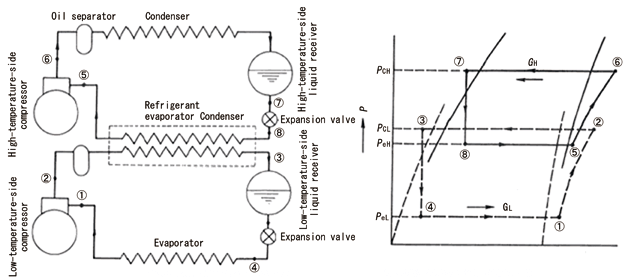
This system is employed to obtain temperatures of -40 to -80°C or ultra-low temperatures lower than them.
At such ultra-low temperatures, a common single-refrigerant two-stage compression system limits the low-temperature characteristics of the refrigerant to a considerably poor level, making the system significantly inefficient. The efficiency is improved by combining two kinds of refrigerants having different temperature characteristics.
This system has the following advantages compared to a two-stage compression system:
- 1. Energy is saved because the system allows use of refrigerants that have suitable temperature characteristics for each of the higher-temperature side and the lower-temperature side.
- 2. It allows stable ultra-low-temperature operation.
- 3. The running cost is inexpensive.
- 4. Repair is easy.
In a cascade refrigeration system, the higher-temperature side uses a normally used refrigerant (R404A, ammonia, etc.), and the lower-temperature side uses R23, which is an HFC refrigerant.
"Kuroshio", a new eco-friendly cascade refrigerator
(Japan) Fluorocarbons Emission Control Law was enacted in 2015.
Although not eligible for the ultra low temperature devices,
refrigeration system should have a GWP value of less than 1500 by 2025.
(Overseas) - Under Paris Agreement, Co2 emission in Japan should be reduced by 26%
between 2020 and 2030.
- Under MOP 28, industrialized countries should reduce GWP converted
HFC refrigerant production by 85% from 2019 to the end of 2035.
mainstream of the ultra-low temperature.
However, they have large GWP values; 3920 for R404A and 14800 for R23.
Recently, ultra low temperature devices using air refrigerant are released, but with low energy efficiency and high power consumption. In addition, being a specific device, it requires high initial and maintenance costs.
refrigerant with less GWP values.
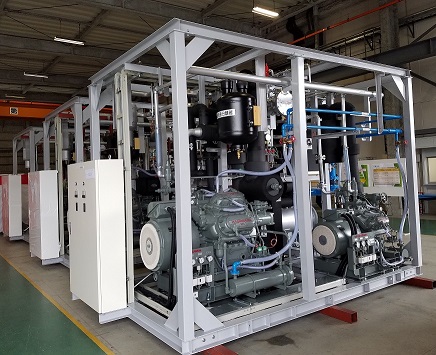
The appearance of Eco-friendly "Kuroshio"
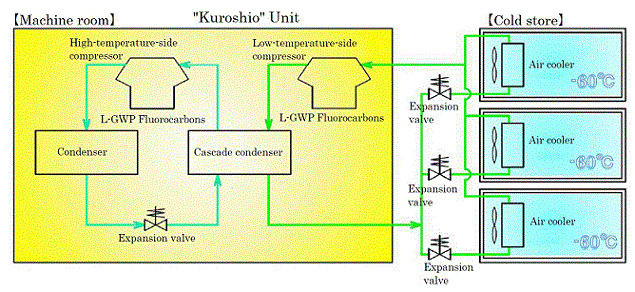
The refrigerant of "Kuroshio" used are R32 (GWP=675) and R407E (GWP=1550).
This reduces GWP of the system by 88%.
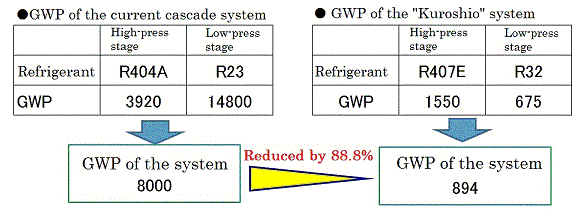
Note that R407E can be replaced in almost a day, even when the new refrigerant
(R454A, GWP=239) appears, that are expected to be released in the future.
The features of "Kuroshio", an evolutionary cascade refrigerator are as follows:
